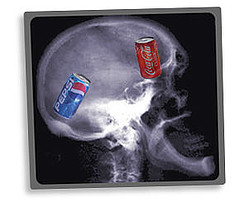O Neuromarketingu, tak ogólnie!
W ostatnim czasie rozmawiałem z kolegą na temat neuromarketingu. Stwierdziłem, że warto skupić się w jednym poście na dokładnym wytłumaczeniu czym dokładnie jest i jak działa w praktyce te potężne narzędzie marketingowe. Pokrótce omówiłem ten proces z poście Każdy z nas żyje, coś sprzedając.
Neuromarketing jest nową gałęzią nauki, która swoje istnienie zawdzięcza neurobiologii. Neurobiologia to dziadzina nauki, której przedmiotem badania jest układ nerwowy. Od działania układu nerwowego zależy proces podejmowania decyzji zakupowych. Dzięki neuromarketingu jesteśmy w stanie stwierdzić jak sygnały wysyłane przez mózg wpływają na konkretną sytuację przy procesie 'kojarzenia marek' czy też właśnie 'samym kupnie produktu'. Według Martina Lindstroma jesteśmy istotami nieracjonalnymi i lubimy okłamywać sami siebie, podawać błędne dane. W chwili gdy pada proste pytanie, czy wolimy produkt x od produktu y, nie zawsze odpowiemy zgodnie z prawdą. Naszym organizmem kierują złożone mechanizmy- w procesie podejmowania decyzji również. Prawdziwą odpowiedź wydobyć należy z podświadomości. Właśnie z tego powodu nie zawsze uświadamiamy sobie jakie są nasze rzeczywiste pragnienia. Dzięki nowej nauce, skupiającej swoją uwagę na naszej 'podświadomości' jesteśmy w stanie odkryć prawdę. Droga ku dotarciu do niej nie jest taka prosta, nie jest to zadanie osobie badanej pytania i czekanie na odpowiedź. Polega na skanowaniu i analizie mózgu podczas rożnych procesów. Z narzędzi, których używa się w tej dziedzinie nauki wyróżniamy trzy najbardziej dokładne- rezonans magnetyczny, tomograf lub elektrody. Nasze mózgi zbudowane są z trzech niezależnych od siebie części, w których podczas badania w łatwy sposób można zaobserwować wzmożoną aktywność pewnych partii mózgu i wysunąć daleko idące wnioski. Dzieląc mózg na trzy części- strefa logicznego myślenia, obszar odpowiedzialny za emocje oraz strefa podejmowania decyzji (najważniejsza w analizie neuromarketingowej).
Czemu warto zainteresować się tymi badaniami? Przede wszystkim, tak jak już pisałem we wcześniejszych postach, każdy z nas jest konsumentem. Wiele firm wypowiada się, że badania neuromarketingowe prowadzone są by produkt dostosować w odpowiedni sposób do preferencji klienteli. W końcu firma chcę 'stworzyć' produkt, który spełniać będzie wszystkie wymagania konsumenta, czerpiąc z tego korzyść nabycia nowego klienta, co przekłada się na korzyść materialną.
Neuromarketing jest bardzo kosztowną metodą badań preferencji konsumentów. Czy ma to rację bytu?
Przede wszystkim rozwój wielu nauk sprzyja biznesowi. W samym marketingu najistotniejszym pytaniem są potrzeby konsumentów i zaspokojenie ich.
Aktualnie z działań neuromarketingowych korzysta wiele dużych korporacji. Z powodu, ze badania są bardzo kosztowne, a przeprowadzone muszą być na dużej grupie ludzi, firmy decydują się na takie zabiegi na przykład by nie wypuszczać na rynek produktów, które się nie sprzedadzą, a firma poniesie olbrzymie koszty (promocja, produkcja, dystrybucja itd.).
Więcej o neuromarketingu z innych źródeł:
Published in Marketing Section of the National
BY KYLE B. MURRAY
What drives people to buy a pet rock? Or a BMW? Or a $5 cup of coffee?
Marketers are interested in these questions, and they have come up with a number of
techniques for figuring out the answers. In many cases they simply ask the consumer.
Sometimes they observe the consumer in action and attempt to deduce the underlying
rationale. In other cases, carefully designed experiments can provide valuable
information about things such as which advertisements do people respond to or what kind
of store layout encourages buying. Nevertheless, market researchers continue to struggle
to better understand what buyers are thinking.
Recently, this has led to the emergence of neuromarketing
– a set of techniques
that aim to look directly into consumers’ brains to see what is going on when buying
decisions are being made. Some early results have demonstrated interesting findings that
fuel continued exploration of the power and potential of neuroscience applied to
marketing.
Take for example, one of this year’s more popular Superbowl commercials: the
FedEx Caveman. During the commercial a caveman’s attempts to send a package are
frustrated by the realities of hominid life during the age of dinosaurs. His boss blames
him when the Pterodactyl carrying his message is eaten by a TRex.
Angry, he storms out
of the cave and is promptly squashed by the foot of some kind of enormous lizard. At
this point, most people watching the ad laugh or giggle and, probably, forget what the ad
was about.However, another interesting thing also happens, a small part of the viewer’s
brain that is known to respond to fearful and threatening stimuli (the amygdala) spikes
with substantially elevated levels of activity. The researchers at UCLA’s AhmansonLovelace
Brain Mapping Center, who have been studying the brain’s response to
Superbowl ads, believe that this spike indicates that the brain is threatened by the image.
From the outside, the response to the ad is one of humor and enjoyment, inside the brain
the response appears to be one of fear. By directly observing this type of neural activity
some researchers believe that they gain valuable insights that allow them to predict
consumers’ preferences.
For example, Read Montague, Director of the Human Neuroimaging Lab at the
Baylor College of Medicine, has demonstrated that many consumers’ brains really do
prefer Coke to Pepsi. Interestingly, and consistent with what Pepsi has been telling us for
years, Montague found that in a blind taste test Pepsi is preferred to Coke. However, he
went further and also conducted the test while scanning the brain activity of a group of
participants while they took the “Pepsi Challenge.” What he found was that Pepsi
produced a stronger response in the ventral putamen, an area of the brain that is believed
to process feelings of reward. However, when Montague told his subjects what they were
drinking he found the preference reversed and most people said they liked Coke more
than Pepsi. And, they weren’t just saying it. Their brains actually reacted differently
when they knew they were drinking Coke. In addition to elevated activity in the ventral
putamen, subjects’ brains were active in areas that are involved in memories, selfimageand action control. It appears that memories and other impressions of the drink – what
marketers would call brand associations – were affecting the consumers’ evaluation ofthe taste. As with the FedEx commercial, the brain scans provided information that the
people themselves were unaware of, but marketers are likely to find useful. Montague
took it a step further and demonstrated that he could predict, based on their brain images
alone, who would prefer Coke and who would chose Pepsi.
Other studies, examining political marketing in the United States, found that
voters’ brains have a strong positive emotional reaction to the party that they affiliate
themselves with. Moreover, Democrats have a strong reaction in their amygdala
(indicative of fear and/or threat) when watching president Bush, while Republicans do
not. Interestingly, a study conducted at Emory University, found that when responding to
political messages the part of the brain associated with reasoning (the dorsolateral
prefrontal cortex) was passive. All of the action was occurring in areas associated with
emotion (orbital frontal cortex), conflict resolution (anterior cingulated) and moral
judgments (posterior cingulated). Moreover, it also appeared that once people arrived at
a conclusion, activity increased in the ventral striatum, which is an area associated with
reward and pleasure.
While some researchers have argued that these sorts of results empower buyers by
making them aware of how they can be influenced, opponents see the application of
neuroscience to the practice of marketing as a disturbing development that requires
oversight and regulation to protect consumers. Opponents are especially troubled by the
fact that this approach can often provide researchers with insights into consumer behavior
that consumers themselves don’t have access to (because brain imaging provides
information about neural activity that is not necessarily consciously available to the
person being scanned – i.e., the brain activity being imaged is often occurring at a non
conscious level). Yet another group of researchers do not believe that this type of
technology will provide us with any truly new insights – for example, is it shocking to
learn that Democrats react negatively to president Bush?
Nevertheless, there is growing interest surrounding these techniques. The allure
of a better understanding of consumer decision making is powerful. As a result,
corporations are likely to continue to make use of tools ranging from traditional
consumer surveys to brain imaging studies. Emerging techniques, such as genetic
profiling, are also likely to play a role in the marketing plans of the future for drug
companies, food manufacturers and others. Neuromarketing
is in its infancy, and if
consumers and society want to play a role in how such technologies are developed and
applied, they should make it a priority to learn more – acting sooner rather than later.
Kyle B. Murray is an Assistant Professor of Marketing and the Director of the Behavioral
Research Lab at the Richard Ivey School of Business at the University of Western
Ontario.
Chcesz dowiedzieć się więcej, jeżeli jeszcze tego nie zrobiłeś zachęcam do zapoznania się z filmami na moim blogu lub zadawania pytań.




Brak komentarzy:
Prześlij komentarz